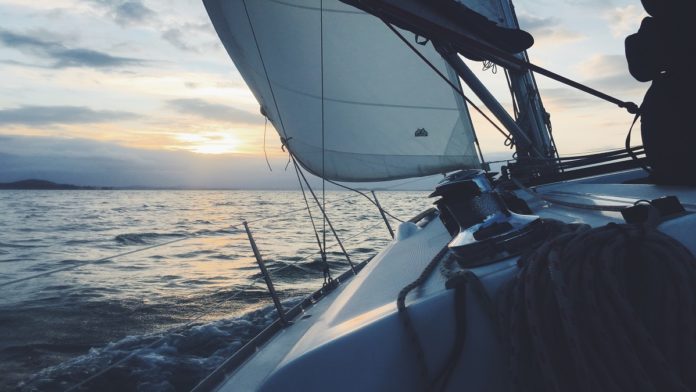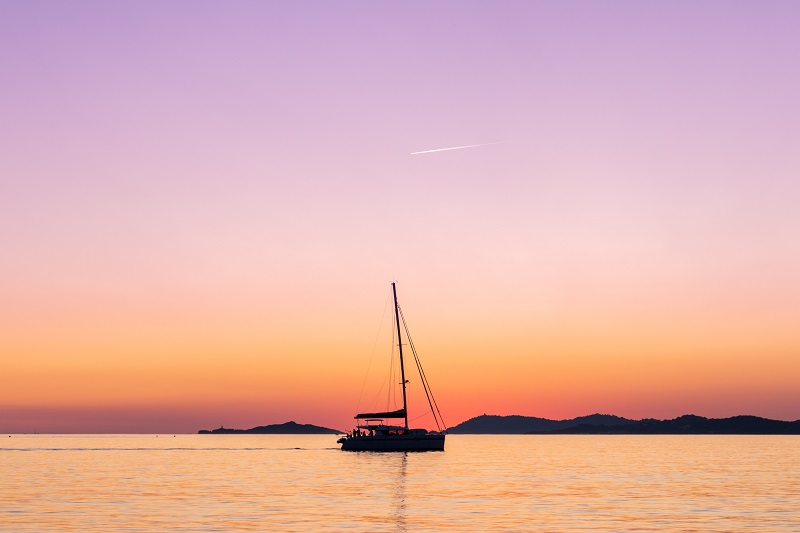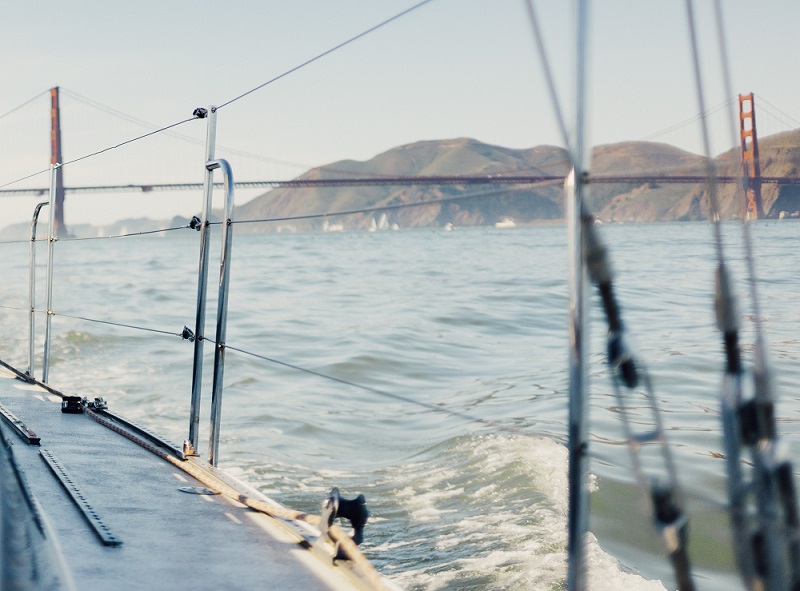
Sailboats are driven by the wind, so the direction of the wind is crucial to how you sail and where you can sail. How close to the wind direction you have to sail affects how the boat moves and how you must sail it.
Points of sail and how sails work


To understand the difference between upwind and downwind sailing, you need to know how sailing works and how boats move against and with the wind. Sailboats can not sail straight into the wind, and to sail in any other direction requires different sail trim positions and rig settings.
How to assess where the wind comes from
Picture a boat on a compass. If the true wind is coming from due north, most sailboats can’t sail in a ninety-degree arc from about 315° through 45°. But the wind rarely blows from absolute north, so it’s the direction of the wind relative to the boat that matters.
Wind at a right angle to the bow (or at 90°) is striking the boat directly on the beam. If the wind is forward of the beam, there will be some upwind sailing. If it is aft of the beam, it’s more downwind. The three major “zones” of sailing are upwind (or close hauled) with the wind forward up to the “no sail zone,” across the wind or reaching from close-hauled through 135°, and downwind or running (135° through 180°). Reaching includes close reaching, which is reaching up to about close hauled, beam reaching with the wind mostly on the beam, and broad reaching off to 135°.
What is the apparent wind?
Riding a bike at knots on a windless day, you’ll feel a “wind” in your face of ten knots. But if you bike into a ten knot wind at the same speed, it will feel like twenty knots. But if the ten knot breeze is directly behind you, you feel no wind at all. If the wind is from your right side, you will feel a breeze from about forty-five degrees ahead and to the right.
True wind is the direction and force of the wind over the water (or land), but the apparent wind is how the total wind feels when you add in the observer’s motion. On a sailboat, apparent wind has an enormous impact on how the boat feels and moves and how you sail.
Read also: The 5 best sailing boats under 60 feet
You sail upwind when you sail against the wind
Sailing close hauled, sails provide lift like an airplane wing to power the boat against the breeze. Sails are trimmed tight with only a slight curve, and the forces against the sails and the keel push the boat forward through the water. The driving sails are the mainsail and a headsail – either a larger Genoa or smaller jib.
Because a sailboat can’t sail straight into the wind, the only way to make progress upwind is to zig-zag upwind, called tacking. When tacking upwind, you sail for a while as close to the wind with the wind over one side of the boat, then you turn the boat across the wind and sail the other direction as close to the wind, repeating as needed to make the best progress upwind.
Read also : How to sail upwind ?
Cross-wind sailing is when the wind is at 90 degrees to the boat’s heading
Reaching across the wind uses the same sails as upwind sailing, but they’re eased back to keep the sails full and drawing. Of all the points of sail, reaching is the most efficient and usually the fastest, though different boats will be a little faster with the wind forward or behind the beam. Some also find it the most comfortable because it is fast and effortless.
You sail downwind when you sail in the same direction of the wind
Once the wind is past a broad reach, the sails stop acting like airplane wings, and catch the wind like parachutes to drive to the boat. For the best performance, sailors use a lighter sail on the front of the boat called a spinnaker. Several varieties of spinnaker offer a range of easier handling and performance, but they’re all characterized by much lighter sailcloth and a very full shape.
How does it feel to sail upwind vs. downwind?
Sailing upwind feels fast, since the boat heels, apparent wind is high, and you’re often sailing straight into wind and chop. Downwind sailing often feels slower because it’s flatter and the wind is at your back so it feels lighter.
Sailing upwind feels faster
Upwind sailing causes a boat to heel – to tip over – as the wind pushes on the sails. The boat feels powered up, all the lines are as taught as bars, and there’s lots of wind and splashing. The boat’s motion increases the apparent wind, so it feels much windier headed upwind.
Usually upwind sailing is into the waves and chop, and the wave period feels shortened because of the boat’s motion. It feels a little rougher and noisier, all of which helps that feel of more speed.
Because of the heeling, the boat may be difficult to move around, and non-sailors may find it unnerving even though it is completely normal. For a day sail or a race, steep angles of heel and lots of tipping aren’t a big deal. But life on board sailing upwind for days offshore adds a challenge to day-to-day tasks like cooking, dressing, and sleeping.
Read also: 10 Sailing Myths And Bad Advice You Shouldn’t Listen To
Sailing upwind requires tacking
Getting some place upwind on a brief trip takes a lot of boat handling. Offshore you may stay on one tack for hours, but sailing on enclosed waters or in a race can have you tacking often. This takes more skill and work, as the crew shifts the boat from side to side.
Sailing distances can be longer upwind
Sailing high upwind means sailing further, because you can’t point straight at your next mark and sail for it. Sailors refer to distance in terms of “velocity made good” because only so much of your speed through the water gets you closer to the mark.
Sailing downwind is usually more comfortable…
Flying a spinnaker can be a lot of work for the person at the helm and the crew trimming the sail, but the boat is flat and usually comfortable. Sailing with a spinnaker can be quick, but the motion is usually good, though there may be some rolling and twisting as the boat moves with the waves in and out of troughs.
Sailing off the wind with upwind sails (jib and main instead of a main and spinnaker) is much less work, and broad reaching is very comfortable. Apparent wind is reduced as you sail down the wind, and it’s usually warmer.
…while sailing upwind is more thrilling
The wind hits your face, the rigging hums, and the sheets are taught. The boat fights into the waves as the crew sits up on the rail to flatten the boat for speed. Upwind sailing feels sportier and is often more of an adrenaline rush than down wind, unless you’re flying a spinnaker in a lot of breeze.
Sailing Downwind can be a lot of work and thrilling, too
Depending on how you choose to sail, you can make a lot of work sailing downwind if you’re really pressing for speed. And a loaded up spinnaker in a big breeze can lead to some fast, fun, white-knuckled sailing. The nice thing is that you don’t have to sail the boat that way. If you want a calm day out sailing down heavy wind, you can just fly a single headsail and move along just fine.
Which is really faster?
Reaching is generally the fastest point of sail, but which is faster between upwind and downwind depends on how you define “faster.”
In straight-line speed through the water with the same sails (jib and main), upwind sailing is faster and downwind sailing feels slow. But if you put a spinnaker up downwind, you’ll usually move more quickly off the wind even though it may feel slower.
But if you measure speed by “movement towards where you’re headed,” then downwind is usually the winner. Because sailing upwind requires tacking back and forth, the net speed towards your next mark is much lower than your speed through the water. But sailing down wind you can often point right at your mark and put all your speed towards getting there.
Read also: Five Easy Beginners-Friendly Sailing Trips And Destinations
Different Yachts in Different Breezes
Yachts designed for different uses handle differently in varying conditions. For example, racing yachts designed for maximum upwind sailing angles may heel aggressively in less wind than a heavier cruising boat. It will sail faster upwind and down, but it may not have the same comfort as the cruising boat. Race boats optimized for downwind conditions will handle better off the wind than those designed for all-around conditions.
Many things affect how a boat feels and sails upwind, including the keel type, displacement, sail plan, rig size, and beam. Boats optimized for stability and comfort often trade stability for sailing angles, giving up a little speed for comfort. And boats built for speed may be just the opposite – getting them sailing their best upwind may take half the crew sitting up on the rail just to flatten out the heel!
Catamaran upwind sailing can be a little different
Catamarans are far more comfortable sailing upwind than monohulls, primarily because they don’t heel. Flat sailing makes a world of difference for crew comfort. Because of their design, catamarans lose a little ability to sail as close to the wind as a similarly sized monohull. But they make up the loss in pointing ability with higher straight-line speed and are faster in many conditions.
Motor yachts are less affected by wind direction
Since power yachts don’t need wind to sail, they can go in any direction. It doesn’t affect how they run, except how the skipper picks a track through the waves that is comfortable and safe.
The wind affects power yachts, since the breeze will push on all the areas above the waterline blowing against it. But course and motoring directions are more heavily affected by waves and water motion than the wind direction.
Use our Sailing Distance calculator
Sailing upwind makes you feel like a sailor
Moving a yacht against the wind isn’t a natural motion – a yacht adrift will always move with the wind and current. Taking the helm and the sheets and making a boat claw her way upwind takes more skill than just steering around and working a throttle.
Sailing downwind in heavy wind can give you a similar rush, and takes a little more skill and daring when the boat is powered up for maximum speed. But sailing off the breeze can be slow and gentle, too. And it’s hard for anything to compare with the rush of taking your boat out into the wind and getting where you want to go despite the elements!

